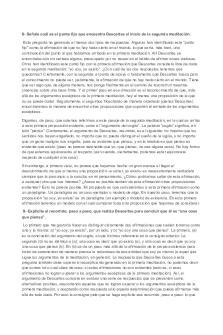Descartes wax argument PDF

| Title | Descartes wax argument |
|---|---|
| Author | Sara Thon |
| Course | Examen philosophicum |
| Institution | Universitetet i Oslo |
| Pages | 2 |
| File Size | 47.2 KB |
| File Type | |
| Total Downloads | 85 |
| Total Views | 141 |
Summary
Analytic text about Descartes' wax argument...
Description
1. Descartes’ wax example Throughout the first and second meditation, Descartes is doubtful about his senses and whether there is anything he can know for certain. He discards anything that admits a sense of doubt in him and treats it as something entirely false. He continues by arguing that his memory is unreliable and only tells him lies, and that his senses are merely illusions of his mind. He concludes by stating that the only true fact is that “nothing is certain”. He tries to figure out what “I” is, which he concludes is something that thinks and understands, but also works through their imagination and senses. As Descartes mentioned, our senses cannot be trusted, which he similarly concludes with our imagination. This poses the question of how he can determine that “I”, meaning him, is a “thinking thing”, while also arguing that his thoughts and imagination are not to be trusted on their own. In order to explore this, Descartes uses the “wax example”. Descartes’ examines a piece of wax, and takes note of its properties such as taste, smell, shape and color. All these features fulfill the requirements for something to be perceived as a physical object, which we recognize through our senses. He then exposes the wax to a flame, which causes the wax to melt, and its physical properties change. Descartes’ notes that the wax becomes warm and melts, whilst also losing its shape, smell and color. Even though all the characteristics he used to recognize the piece of wax have changed, he argues that it is the same piece of wax as before. This indicates that an object remains the same object, even after its physical traits change. Furthermore, Descartes’ main argument is that the wax is not merely a sum of its sensory characteristics, but rather that the “essence” of the wax manifests in our minds. Descartes’ further proves his argument when he states that “I do not grasp what this wax is through the imagination; rather, I perceive it through the mind alone.” (Knowing, being, doing, 2021) His perception of the wax is not based on its sensory attributes but is rather an “inspection of the mind alone”. Throughout his meditation, he refers to the wax example in order to understand his mind and how it is further proof of his thoughts and that he exists. If he judges that the wax exists because he can see it, it could be that he is deceived by his senses because as he mentioned earlier, they cannot be trusted. But if he can judge that the wax exists based on the fact that he can see it, then evidently, he must also exist because he can see the wax. Aditionally, if he judges that the wax exists because he can touch it, then he too must exist. However, he argues that the fact that he understands the wax through his mind, and not only relying on his senses, he becomes more distinctly known to himself. Descartes’ wax argument demonstrates how our perception of changes in objects are very different through what our senses and what
our minds tell us about an object. In conclusion, it is our minds that are able to notice the “essence” of a thing and help us identify it. Our senses are deceiving, which makes our minds more reliable....
Similar Free PDFs

Descartes wax argument
- 2 Pages

Descartes Wax Paper
- 2 Pages

Argument of the Wax Analysis
- 3 Pages

Descartes
- 1 Pages

Argument
- 3 Pages

Disertación Descartes
- 6 Pages

Descartes Redacción
- 3 Pages

Descartes 2020
- 10 Pages

Descartes - ffss
- 3 Pages

Comentario Descartes
- 1 Pages

Aristoteles, Descartes
- 2 Pages

Descartes - Meditationen
- 85 Pages

Descartes Erkenntnistheorie
- 26 Pages

Hausarbeit Descartes
- 14 Pages
Popular Institutions
- Tinajero National High School - Annex
- Politeknik Caltex Riau
- Yokohama City University
- SGT University
- University of Al-Qadisiyah
- Divine Word College of Vigan
- Techniek College Rotterdam
- Universidade de Santiago
- Universiti Teknologi MARA Cawangan Johor Kampus Pasir Gudang
- Poltekkes Kemenkes Yogyakarta
- Baguio City National High School
- Colegio san marcos
- preparatoria uno
- Centro de Bachillerato Tecnológico Industrial y de Servicios No. 107
- Dalian Maritime University
- Quang Trung Secondary School
- Colegio Tecnológico en Informática
- Corporación Regional de Educación Superior
- Grupo CEDVA
- Dar Al Uloom University
- Centro de Estudios Preuniversitarios de la Universidad Nacional de Ingeniería
- 上智大学
- Aakash International School, Nuna Majara
- San Felipe Neri Catholic School
- Kang Chiao International School - New Taipei City
- Misamis Occidental National High School
- Institución Educativa Escuela Normal Juan Ladrilleros
- Kolehiyo ng Pantukan
- Batanes State College
- Instituto Continental
- Sekolah Menengah Kejuruan Kesehatan Kaltara (Tarakan)
- Colegio de La Inmaculada Concepcion - Cebu

